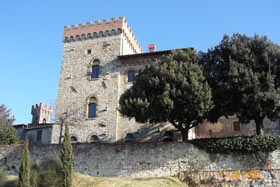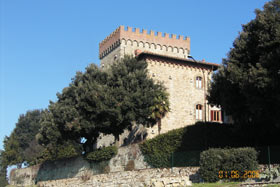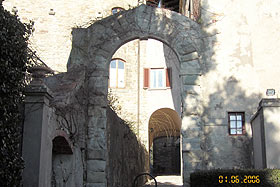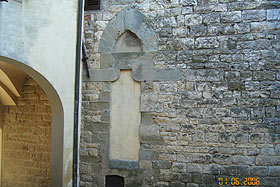Castle of Volognano
 |
 |
The Castle of Volognano is reached by following the SP34 road that connects Florence and Rosano. From Rosano follow the SP90 towards Rignano sull’Arno.
 Situated
at the top of one of the last hills of the Poggio di Firenze that slope
down to the Arno, the Volognano Castle has a dominant position both strategic
and scenic near where the Arno and Sieve rivers merge and close to the
territories of Pontassieve, Vallombrosa, Pratomagno, and Valdarno.
Situated
at the top of one of the last hills of the Poggio di Firenze that slope
down to the Arno, the Volognano Castle has a dominant position both strategic
and scenic near where the Arno and Sieve rivers merge and close to the
territories of Pontassieve, Vallombrosa, Pratomagno, and Valdarno.
The origin of this settlement seems to be from the Roman era. Remains from this period have been found at the Bertinga farm on a hill west of the castle. The village was mentioned for the first time in 1214 in a document pertaining to the church of San Michel a Volognano, while the castle is mentioned on a map from the monastery of Vallombrosa dated 1220 and in an act from 1299 stipulating 'castro de Volognano'. In the middle ages the castle was the residence of the Quona family, overlords of the castle by the same name above Remole where they lived until the castle is destroyed by the Florentines in 1143. Established at Volognano they adopt this name to distinguish themselves from other branches of the family. The Da Quona da Volognano were involved in the arson of the center of Florence during the battle between the Guelphs and the Ghibellines and for this reason, in 1304 the Guelph government occupied and destroyed the castle, after repossessing everything they found there.
 The
lowered tower, tracts of masonry made of alberese stone laid in regular
and parallel lines, an entrance way made of an ogive arch, the finish
of the stones still visible on one side of the tower, make it plausible
to date the castle from the 13th century.
The
lowered tower, tracts of masonry made of alberese stone laid in regular
and parallel lines, an entrance way made of an ogive arch, the finish
of the stones still visible on one side of the tower, make it plausible
to date the castle from the 13th century.
The actual appearance is that of a villa/farm house of decided neo-gothic taste, still dominated by the strong crenellated tower of the keep. The church of San Michele is located in the interior of the castle in the center of small courtyard. The whole structure is surrounded by a elliptical shaped wall crossed by a single street to which entrance is made from a door with an ogive arch, partially preserved. Residences and infrastructures were built here in the course of centuries.
| Sponsored Link |
| Vacation
in Tuscany and Italy Specializing in hotels, farmhouses, villas, apartments, B&B’s in Italy. Accommodations in Tuscany, Florence, Siena, San Gimignano, Rome and Venice ...[»»»] |
| Back to Homepage |
| Back to Castles Index |